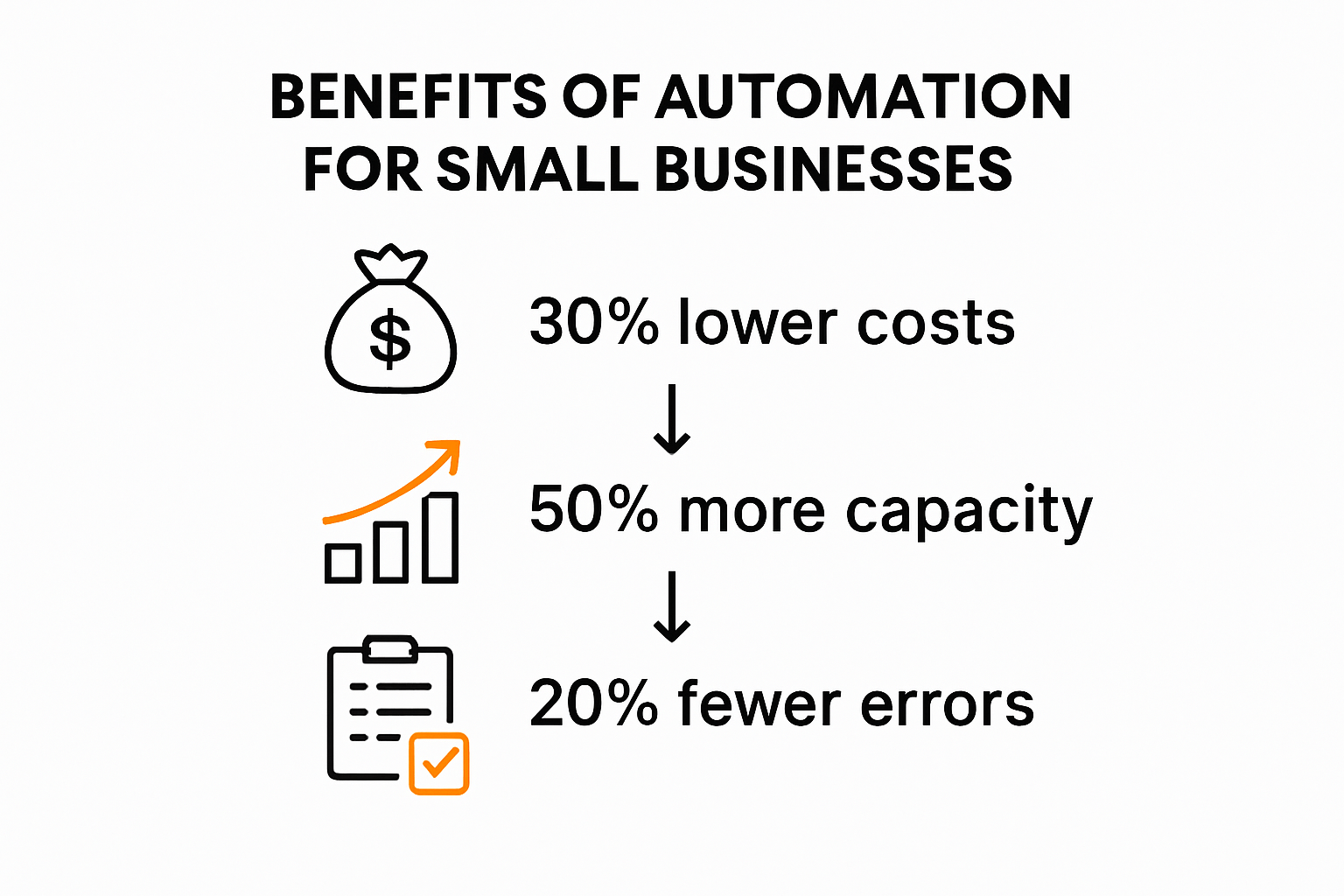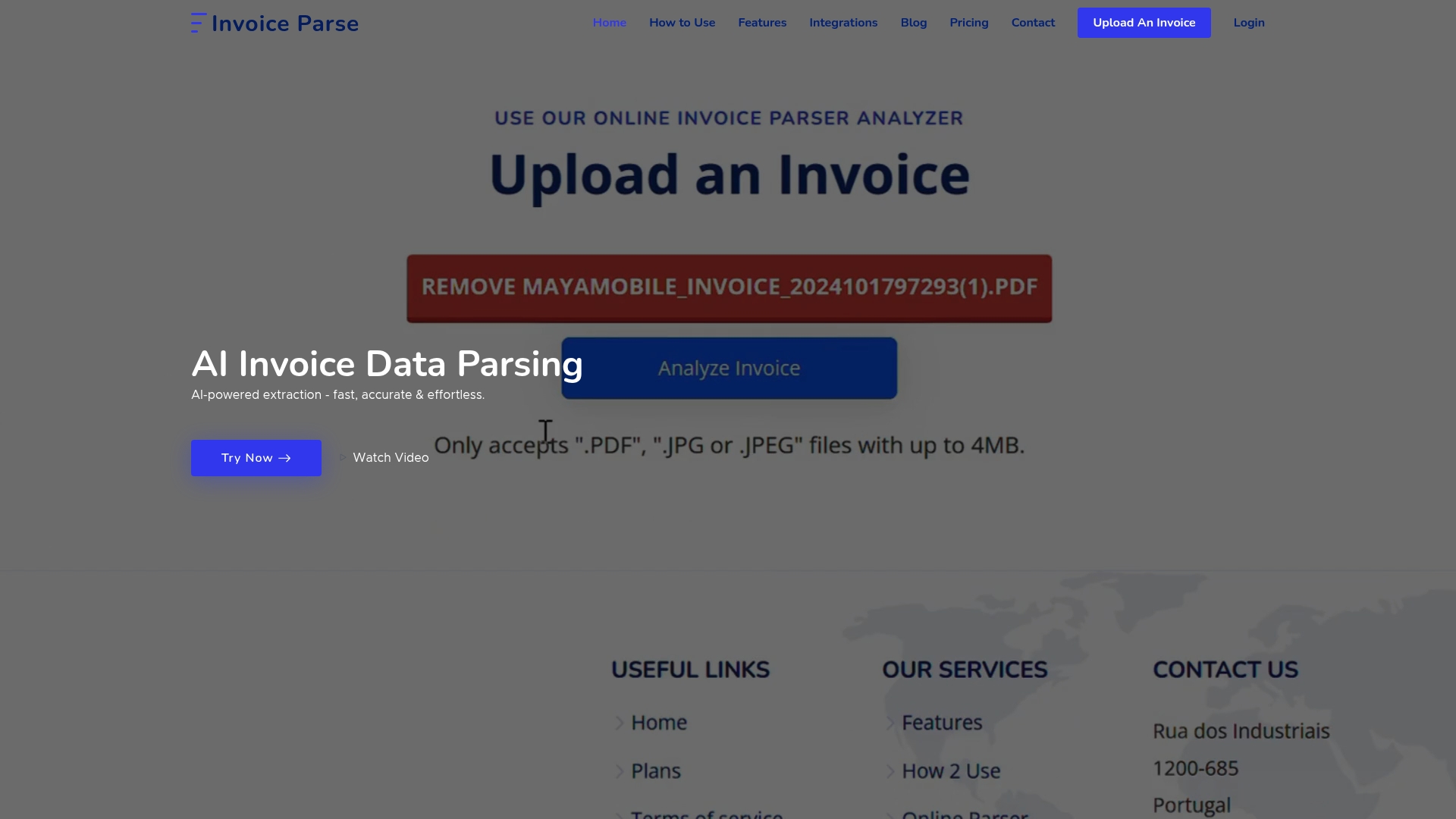Small businesses are talking about automation more than ever. It sounds futuristic and complex, yet more than 80 percent of owners who use automation see major improvements in how their business runs. You might think it is just about cutting back on staff or saving money fast. Actually, it is more about giving your team the freedom to do their best work while technology handles the boring stuff.

Understanding Automation for Small Businesses
Table of Contents
- What Is Automation And Its Role In Small Businesses?
- The Importance Of Automation: Benefits For Small Enterprises
- How Automation Works: Key Technologies And Processes
- Pitfalls And Considerations In Small Business Automation
- Real-World Examples Of Successful Automation In Small Businesses
Quick Summary
| Takeaway | Explanation |
|---|---|
| Automation enhances operational efficiency. | By minimizing human intervention, automation streamlines repetitive tasks, significantly improving productivity for small businesses. |
| Identify and address process bottlenecks. | Successful automation begins with recognizing inefficiencies to select the best technological solutions tailored to specific needs. |
| Empower employees through automation. | Automation should free employees from routine tasks, allowing them to focus on strategic activities that drive growth and innovation. |
| Select technologies that align with goals. | Choosing the right tools is critical; they should support specific business objectives and operational needs for a successful implementation. |
| Implement gradual changes with training. | A careful rollout of automation ensures smoother transitions, supported by comprehensive employee training and clear performance metrics. |
What is Automation and Its Role in Small Businesses?
Automation represents a strategic approach where businesses use technology to perform tasks and processes with minimal human intervention. For small businesses, automation is not just a technological upgrade but a critical competitive strategy that transforms operational efficiency and productivity.
Understanding the Core of Business Automation
At its fundamental level, automation for small businesses involves using software, artificial intelligence, and integrated systems to streamline repetitive tasks. These tasks might include data entry, invoice processing, customer communication, inventory tracking, and financial reporting. Learn more about invoice automation techniques that can significantly reduce manual workload.
According to research from the Bipartisan Policy Center, over 80% of small business owners who implement automation technologies experience substantial improvements in operational efficiency. The key benefits include:
- Reduced human error in routine tasks
- Significant time savings across multiple business functions
- Enhanced accuracy in data management and processing
- Lower operational costs through efficient resource allocation
Strategic Advantages for Small Business Growth
Automation is not about replacing human workers but empowering them to focus on higher-value strategic activities. By automating routine and repetitive tasks, small businesses can redirect human talent towards creative problem solving, customer relationship management, and business development.
Modern automation tools are becoming increasingly accessible and user friendly. Small businesses can now implement sophisticated automation solutions without requiring extensive technical expertise or massive financial investments. From cloud based platforms to AI powered software, technology has democratized automation, making it a viable strategy for businesses of all sizes.
The most successful automation implementations occur when businesses carefully analyze their existing processes, identify bottlenecks, and strategically select technologies that align with their specific operational needs and growth objectives.
The Importance of Automation: Benefits for Small Enterprises
Automation has transformed from a luxury to a necessity for small businesses seeking competitive advantage in today’s rapidly evolving digital landscape. By leveraging technological solutions, small enterprises can dramatically enhance their operational capabilities and strategic positioning.
Financial and Operational Efficiency
The primary benefit of automation for small businesses lies in its ability to optimize resource allocation and reduce operational costs. Dive into practical bookkeeping automation strategies that can help streamline financial processes. According to research from the Information Technology and Innovation Foundation, small and medium-sized enterprises can significantly improve their productivity through strategic technological implementations.
Key financial advantages of automation include:
- Reduced labor costs associated with manual tasks
- Minimized errors in financial record keeping
- Faster processing of transactions and reports
- More accurate budget forecasting and financial planning
Competitive Scalability and Growth
Automation provides small businesses with the tools to compete against larger organizations by enabling them to work smarter, not harder. By automating repetitive tasks, businesses can allocate human resources toward more strategic, creative endeavors that drive innovation and growth.
Technological solutions allow small enterprises to:
- Handle increased workload without proportional increase in staffing
- Provide faster customer response times
- Maintain consistent service quality
- Adapt quickly to market changes and customer needs
The strategic implementation of automation technologies enables small businesses to punch above their weight, delivering professional grade services and operational efficiency traditionally associated with larger corporations. By carefully selecting and integrating automation tools, small enterprises can transform their operational model, creating a robust foundation for sustainable growth and long term success.

How Automation Works: Key Technologies and Processes
Automation represents a sophisticated ecosystem of interconnected technologies designed to transform manual business processes into efficient, streamlined operations. Understanding the underlying mechanisms helps small businesses implement intelligent solutions that drive productivity and innovation.
Core Technological Infrastructure
Learn about advanced data extraction techniques that power modern automation systems. The technological foundation of business automation involves several critical components that work seamlessly to reduce human intervention and increase operational efficiency.
To better understand the essential technological building blocks behind automation for small businesses, the following table outlines the core technologies mentioned and their roles in streamlining operations.
| Technology Component | Role in Automation |
|---|---|
| Artificial Intelligence (AI) & Machine Learning | Enables intelligent data analysis and decision-making processes |
| Robotic Process Automation (RPA) | Automates repetitive, rules-based tasks across business functions |
| Cloud Computing Infrastructure | Provides scalable, flexible access to software and data |
| Application Programming Interfaces (APIs) | Connects different software tools to integrate workflows |
| Advanced Data Integration & Workflow Management | Streamlines information sharing and coordinates task execution |

Key technological components include:
- Artificial Intelligence (AI) and machine learning algorithms
- Robotic Process Automation (RPA) platforms
- Cloud computing infrastructure
- Application Programming Interfaces (APIs)
- Advanced data integration and workflow management systems
According to research from Digital.gov, Robotic Process Automation technologies can rapidly design, test, and deploy automations that eliminate repetitive, rules-based tasks across various business functions.
Workflow Automation Mechanisms
Automation technologies function through a series of interconnected processes that analyze, interpret, and execute tasks with minimal human oversight. These systems utilize sophisticated algorithms and predefined rules to:
- Recognize and categorize incoming data
- Trigger specific actions based on preset conditions
- Generate reports and insights automatically
- Integrate information across multiple platforms
- Maintain consistent performance standards
By leveraging these technological capabilities, small businesses can create intelligent systems that adapt to changing operational requirements, reduce errors, and optimize resource allocation. The most effective automation strategies focus on identifying repetitive, time consuming tasks and implementing targeted technological solutions that enhance overall business performance.
Pitfalls and Considerations in Small Business Automation
While automation offers tremendous potential for small businesses, successful implementation requires strategic planning and thoughtful execution. Understanding potential challenges helps organizations navigate technological transformations more effectively and avoid costly mistakes.
Strategic Implementation Challenges
Explore bookkeeping automation strategies that help mitigate common implementation risks. According to research on business process automation, small businesses frequently encounter several critical challenges during technological integration.
Key strategic implementation challenges include:
The following table summarizes some of the most common challenges small businesses face when implementing automation, as highlighted in the article. This overview can help organizations anticipate and address these hurdles during strategic planning.
| Implementation Challenge | Description |
|---|---|
| Selecting inappropriate solutions | Choosing tools that do not match business needs or workflows |
| Underestimating financial investments | Failing to account for true costs of automation setup and operation |
| Neglecting employee training | Not providing comprehensive training on new systems |
| Failing to align with business objectives | Implementing automation without supporting specific goals |
| Overlooking workflow complexities | Ignoring existing process intricacies during technology adoption |
- Selecting inappropriate technological solutions
- Underestimating required financial investments
- Neglecting comprehensive employee training
- Failing to align automation with specific business objectives
- Overlooking existing workflow complexities
Technology Adoption and Change Management
Successful automation extends beyond technological selection. Small businesses must develop robust change management strategies that address human factors and organizational culture. Effective approaches involve:
- Transparent communication about technological transitions
- Gradual implementation with continuous feedback mechanisms
- Providing comprehensive training and skill development
- Creating opportunities for employee involvement
- Establishing clear performance metrics
The most successful automation initiatives recognize that technology serves organizational goals. By maintaining a balanced approach that prioritizes both technological capabilities and human expertise, small businesses can create sustainable automation strategies that drive meaningful operational improvements without disrupting existing workflows.
Real-World Examples of Successful Automation in Small Businesses
Real world automation success stories demonstrate how strategic technological implementation can transform small business operations, drive efficiency, and create competitive advantages across various industries. These practical examples illustrate the tangible benefits of thoughtful automation approaches.
Manufacturing and Production Automation
Explore invoice automation benefits that can inspire broader automation strategies. According to research from the U.S. Small Business Administration, small manufacturers have successfully leveraged automation to enhance operational capabilities.
Notable manufacturing automation examples include:
- Red Land Farms implementing advanced tracking systems
- ATEK Distribution optimizing inventory management
- Quest Safety Products integrating high precision manufacturing technologies
- Olson Custom Designs utilizing computer numerical control (CNC) machinery
Service and Administrative Automation Strategies
Beyond manufacturing, service businesses have discovered powerful automation opportunities that streamline complex administrative processes. Small businesses across sectors are transforming traditional workflows through intelligent technological solutions.
Successful service sector automation approaches demonstrate:
- Reduced manual data entry in financial services
- Automated customer communication systems
- Intelligent scheduling and appointment management
- Real time reporting and analytics integration
- Simplified compliance and documentation processes
These real world examples underscore a critical insight: automation is not about replacing human workers but empowering them to focus on higher value strategic activities. By carefully selecting and implementing targeted technological solutions, small businesses can unlock unprecedented levels of operational efficiency and competitive advantage.
Unlock Hassle-Free Invoice Automation for Small Business Success
Are you spending valuable work hours on repetitive tasks like manually entering invoice data or fixing errors from old-fashioned systems? The article highlighted how automation empowers small businesses to cut costs, reduce mistakes, and let teams focus on strategic growth. But if you still depend on manual invoice processing, you are missing out on one of the simplest ways to boost both speed and accuracy.

See the difference Invoice Parse can make. Our easy-to-use platform lets you instantly extract vendor names, totals, dates, and more from any PDF or image invoice without templates or complicated setup. Experience quick drag-and-drop uploads, live analysis, and seamless integration with tools like Excel and Power BI. Visit Invoice Parse and unlock your free trial. Make today the day your business rises above bottlenecks and enjoys smarter, scalable automation.
Frequently Asked Questions
What is automation for small businesses?
Automation for small businesses involves using technology to perform repetitive tasks with minimal human intervention, enhancing operational efficiency and productivity.
What are the key benefits of implementing automation in a small business?
The key benefits include reduced human error, significant time savings, enhanced accuracy in data management, lower operational costs, and the ability to allocate resources toward higher-value activities.
How can automation help in financial efficiency for small businesses?
Automation can streamline financial processes, reduce manual labor costs, minimize errors, and allow for faster processing of transactions and accurate financial reporting.
What challenges do small businesses face when implementing automation?
Challenges can include selecting the wrong technologies, underestimating financial investments, neglecting employee training, and failing to align automation with specific business objectives.
Recommended
- AI Invoice Parse – How to Automate Bookkeeping: Simple Steps for 2025
- AI Invoice Parse – Invoice Automate Guide: Streamline Invoicing in 2025
- AI Invoice Parse – Key Benefits of Invoice Automation for Businesses
- AI Invoice Parse – Automated Invoice Reconciliation: Save Time and Reduce Errors
- Understanding Marketing Automation for Small Business 2025 - Zoo Digital
- The Ultimate Guide to Small Business Automation: A 2025 Playbook for The Chief Everything Officer | 12AM Agency
